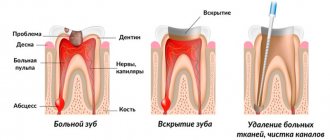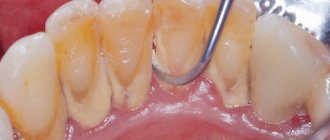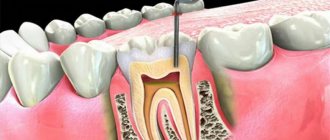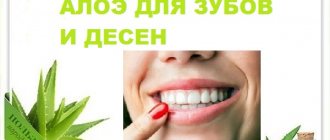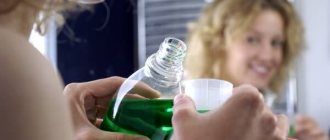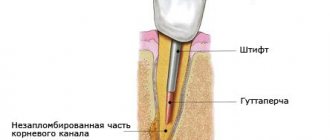Features of professional cleaning
Modern methods of removing tartar are a safe and comfortable procedure. Even pregnant women can undergo professional cleaning.
Teeth brushing is a virtually painless procedure; in very rare cases, the patient is given application anesthesia. Removal of tartar and plaque is carried out in several stages:
- Stone removal.
The main stage of professional teeth cleaning is the removal of tartar under the influence of ultrasound. The stone easily comes off the surface of the teeth and is cleaned off. - Cleaning using an Air Flow device.
Under pressure, abrasive particles are delivered to the tooth surface from a special apparatus with a stream of water. The particles not only clean, but also whiten the enamel, making it 1-2 shades brighter. - Polishing of hard tooth tissues.
After brushing, the surface of the enamel becomes slightly rough, and if left in this condition, tartar will very quickly begin to form on the surface of the teeth. To prevent this from happening, teeth are treated using special rubber discs and brushes. After polishing, the enamel becomes smooth, which protects it from negative influences. - Antiseptic treatment.
Prevention of periodontal inflammation during professional teeth cleaning is antiseptic treatment of the oral cavity. The use of antiseptics will stop the spread of infection and avoid additional complications. - Fluoridation of teeth.
This stage of treatment is mandatory if the patient's enamel is weak, sensitive and prone to destruction. After cleaning, fluoride varnish is applied to the teeth, which helps strengthen the enamel. - Use of medicinal dressings.
In case of severe periodontal inflammation, bleeding or significant trauma to the gums that occurred during the removal of dental plaque, the doctor may decide to use therapeutic dressings. Dressings are prepared before use and may contain antibiotics, antiviral drugs, enzymes, antiseptics or sulfonamides.
Reasons why the roof of your mouth may hurt
The upper part of the oral cavity, covered with mucous membrane, is divided into 2 parts - the hard and soft palate. The hard part is the bone wall that separates the oral and nasal cavities. It begins just behind the front teeth and smoothly transitions into the soft fold of mucous membrane near the base of the tongue that separates the oral cavity from the pharynx.
To find out why the roof of your mouth hurts, you should consult a dentist, since there are many prerequisites leading to the appearance of such symptoms. Below are just a few of them:
- People eat hot and hard foods every day, which can burn or scratch areas of the roof of the mouth, both near the front teeth and closer to the throat. And in addition, many people forget about basic hygiene rules, as a result of which harmful microorganisms develop in the oral cavity - and the mucous membrane covering it becomes inflamed. It should be remembered that even a small wound is susceptible to infection.
- The cause of pain in the palate and the appearance of a white coating on it can be a fungal infection. The most common causative agent of oral inflammation is Candida fungus, which can affect not only the inside of the mouth, but also the lips. Candidiasis or fungal stomatitis often occurs in girls and infants.
- The palate can become inflamed when the herpes virus is activated. This disease manifests itself not only externally (on and around the lips), but also inside the mouth. Patients feel itching in the affected area, and sometimes their body temperature rises.
- With the development of tonsillitis, a sharp enlargement of the tonsils is observed, accompanied by their redness. Sometimes with this disease, the upper palate becomes inflamed and swollen, turning a bright red hue.
- Don’t forget about one of the most common diseases of children and adults – caries. It usually affects only the teeth, but the infection can spread to the surrounding soft tissue.
- Inflammation of the palatal tissues may indicate the formation of a benign tumor, so it is important to constantly monitor your condition.
- If the soft tissues of the tongue and palate on top are swollen and covered with whitish spots, it is worth checking for the presence of leukoplakia. This disease develops in those who often eat hot food, come into contact with chemicals, as well as in people with improperly installed dentures or chipped teeth.
- The cause of inflammation of the palate is often the passage of procedures using galvanic current - when installing braces, crowns, and during some types of dental treatment.
- Redness, swelling and irritation of the gums and other soft tissues inside the mouth in adults can be caused by smoking and drinking alcohol.
Signs of inflammation of the palate in the mouth are varied and depend on the cause of its development, so self-diagnosis in this case is difficult. That is why it is necessary to contact a specialist with this problem as quickly as possible to make an accurate diagnosis and prescribe a course of treatment.
Sometimes areas of the soft palate closer to the throat swell due to allergies to medications. If pain is felt while taking medication, you should stop treatment and consult a doctor. If the soft tissue swells too quickly, an antihistamine should be taken.
Causes of inflammation
Unpleasant sensations almost always occur after dental procedures. The main reason why inflammation occurs is the increased sensitivity of hard and soft tissues. Oral sensitivity can be an individual characteristic of the patient or a consequence of gingivitis, periodontitis, periodontal disease and other gum diseases. Often the cause of such problems is tartar.
Exacerbation of the pathology also provokes medical intervention, and after cleaning, gum inflammation intensifies. However, if you follow all the doctor’s recommendations, the unpleasant symptoms subside within a few hours or days.
The causes of gum inflammation after professional teeth cleaning can also be:
- enamel microcracks;
- caries;
- incorrectly selected toothpaste;
- toothbrush too hard;
- soft tissue injuries;
- mucosal lesions;
- inflammation of the gums;
- pulpitis;
- periodontitis.
Rehabilitation after cleaning
To prevent gum inflammation from starting after professional teeth cleaning, the patient should be attentive to himself and follow all the doctor’s recommendations regarding rehabilitation. Correct behavior and oral care will allow you to consolidate the results of cleaning for a long time, eliminate inflammation and prevent its complications.
Diagnosis of burning in the mouth
In most cases, burning of the oral mucosa is not at all associated with diseases of the teeth and gums. Despite this, if you feel itching, you should first contact your dentist, especially if you have recently had prosthetics or fillings done.
The specialist will examine the oral cavity and, if dental problems are detected, prescribe the necessary treatment. In addition, the dentist can give recommendations on how to eliminate dry mouth, because it is the precursor to discomfort. In this case, even traditional methods will be useful.
If the dentist was unable to cure the patient, he will have to undergo a series of tests and examinations by a neurologist, gastroenterologist, otolaryngologist and endocrinologist. First of all, blood is collected and a swab is taken from the tongue. Once the original disease is identified, the patient will be prescribed the correct treatment.
Treatment of inflammation
If gum inflammation appears solely as a result of professional teeth cleaning, several simple ways can reduce the negative manifestations:
- Do not eat rough foods within 24 hours after cleansing.
- For 12 hours, exclude drinks that stain the enamel - coffee, wine, natural citrus juices.
- Immediately after cleansing, avoid drinking too hot or cold drinks for 2-3 hours.
- When you get home, immediately replace your old toothbrush with a new one and do not use it for more than 3 months.
- Visit your dentist every six months for an oral exam and professional cleaning.
If your gums hurt for more than a day after professional cleaning and the discomfort does not subside, it may be caused by some kind of complication. If you have a long-term pain attack, be sure to visit the dentist.
Before visiting a specialist, painful sensations can be relieved with the help of painkillers and anti-inflammatory drugs.
What is white plaque on the wound after tooth extraction?
A few hours after the tooth is removed, a dark clot appears in the socket - bluish, black, red or brown. This clot is blood, and it is the primary protection of the socket from bacteria or pieces of food entering it. On the 2nd - 4th day, the patient may see that a coating appears on the clot - yellowish, gray or white. The deposit looks like pus and, together with the resulting bad breath, can alert the patient. However, there is no need to be alarmed - this plaque is not a sign of wound decay and indicates a normal healing process. This special protein compound is fibrin.
A milky plaque (fibrinous) can be very dense, hard or soft. This is no cause for concern. If you come to the dentist with this question for an unscheduled appointment, the specialist will tell you that everything is in order and there is no need to remove the film.
If the film is not removed and the wound is not disturbed, active processes will occur underneath it:
- the blood clot will begin to dissolve;
- the hole will begin to decrease in size;
- young cells, osteoblasts, will begin to move from the edge of the wound to the center;
- The gums will begin to close the wound.
Fibrinous plaque after tooth extraction is a natural stage of gradual recovery of the body, in which it is better not to interfere.
Folk remedies for relieving gum pain
Simple folk recipes will also help relieve gum inflammation and soothe the tissues:
- Prepare a decoction of sage and chamomile by taking a tablespoon of the raw material and pouring a glass of boiling water over it. The herbs must be infused in a steam bath for 15-20 minutes, and then rinsed throughout the day. As a rule, the pain noticeably subsides after the third rinse.
- A solution of baking soda can quickly eliminate gum inflammation after professional teeth cleaning. It is enough to dissolve a teaspoon of baking soda in a glass of water and rinse your mouth with the mixture several times a day.
For acute inflammation of the gums, dentists advise using the unique ASEPTA gel with propolis. The product with the waste product of bees provides action in four directions: antimicrobial, anti-inflammatory, healing and analgesic.
We hope that gum inflammation after brushing your teeth will not torment you, and this hygiene procedure will become your usual care and a way to maintain a healthy, snow-white smile.
Sources:
- Report on clinical trials to determine/confirm the preventive properties of commercially produced personal oral hygiene products: mouth rinse "ASEPTA PARODONTAL" - Solution for irrigator." Doctor of Medical Sciences Professor, Honored Doctor of the Russian Federation, Head. Department of Preventive Dentistry S.B. Ulitovsky, doctor-researcher A.A. Leontiev First St. Petersburg State Medical University named after academician I.P. Pavlova, Department of Preventive Dentistry.
- Report on clinical trials of anti-inflammatory balm for gums "Asepta" adhesive, St. Petersburg State Medical University, 2007
- The role of anti-inflammatory rinse in the treatment of periodontal diseases (L.Yu. Orekhova, A.A. Leontyev, S.B. Ulitovsky) L.Yu. OREKHOVA, Doctor of Medical Sciences, Prof., Head of Department; A.A. LEONTIEV, dentist; S.B. ULITOVSKY, Doctor of Medical Sciences, Prof. Department of Therapeutic Dentistry of St. Petersburg State Medical University named after. acad. I. P. Pavlova

